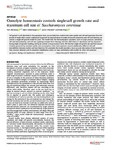Osmolyte homeostasis controls single-cell growth rate and maximum cell size of Saccharomyces cerevisiae
Altenburg, Tom
Goldenbogen, Björn
Uhlendorf, Jannis
Klipp, Edda
Cell growth is well described at the population level, but precisely how nutrient and water uptake and cell wall expansion drive the growth of single cells is poorly understood. Supported by measurements of single-cell growth trajectories and cell wall elasticity, we present a single-cell growth model for yeast. The model links the thermodynamic quantities, such as turgor pressure, osmolarity, cell wall elasto-plasticity, and cell size, applying concepts from rheology and thin shell theory. It reproduces cell size dynamics during single-cell growth, budding, and hyper-osmotic or hypo-osmotic stress. We find that single-cell growth rate and final size are primarily governed by osmolyte uptake and consumption, while bud expansion requires additionally different cell wall extensibilities between mother and bud. Based on first principles the model provides a more accurate description of size dynamics than previous attempts and its analytical simplification allows for easy combination with models for other cell processes.
Dateien zu dieser Publikation

